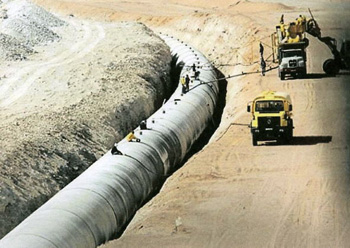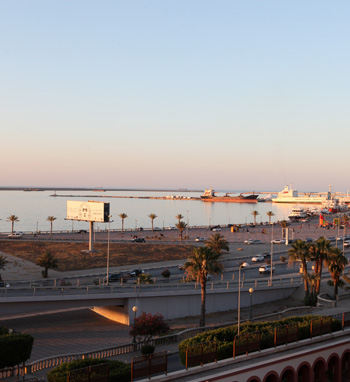Large electricity and desalination projects to upgrade Libya’s ageing infrastructure
Libya Sector Analysis
Large Electricity and Desalination Projects to Upgrade Libya’s Ageing Infrastructure
Power was a priority once the fighting stopped, with the repairing and improving the electricity grid a key are of focus. According to estimates, the grid was damaged to the tune of US $1 billion. Repair work began in September 2011 and by the end of 2013 over 70 percent of the power network had been repaired.

Large Electricity and Desalination Projects to Upgrade Libya’s Ageing Infrastructure
By TK Maloy
TRIPOLI – Looking at Libya’s infrastructure – its transportation, telecoms, broadband, electrical power and water sectors – the issue is not just fixing what might have been damaged during the rebellion, instead there is both an impetus to repair but also to build out an improved infrastructure as the country is reopening itself to foreign business and increased business and industrial activity domestically.
According to estimates, the grid was damaged to the tune of US $1 billion. Repair work began in September 2011 and by the end of 2013 over 70 percent of the power network had been repaired.
Electricity Sector
Power was a priority once the fighting stopped, with the repairing and improving the electricity grid a key are of focus. According to estimates, the grid was damaged to the tune of US $1 billion. Repair work began in September 2011 and by the end of 2013 over 70 percent of the power network had been repaired.
That said, the electricity sector could be described as Libya’s most troubled part of the infrastructural systems, based on public criticism of constant power outages.
In a recent press conference covered by the The Saudi Gazette, Libyan Electricity Minister Ali Muhairig noted that his ministry “cannot create miracles.”
The minister has become the object of much criticisms on local social network sites because of the “chronic power cuts in Western and Southern Libya, with some areas reporting up to 12 hours of power cuts,” the Saudi paper reported.
Muhairig said the problems was not a result of staff incompetency, thanking sector employees for efforts in repairing and maintaining the flow of electricity during the fasting month of Ramadan.
He added that the media should qualify news reports with the fact that the electricity sector suffered more than LYD 1 billion in damage during the rebellion.
 The blame apparently goes to lawless militias and other armed groups attacking power stations and related facilities.
The blame apparently goes to lawless militias and other armed groups attacking power stations and related facilities.
The minister said that Central Control headquarters, which controls all electricity supply within Libya, was recently attacked by an armed group. He also revealed that an attack that hit the Tripoli South station resulted in the theft of ministry vehicles and he reported an attack on the Sirte power station which was destroyed and valuable equipment stolen.
“Employees are working round the clock to return services to normal,” Ali Muhairig told the Saudi daily.
“We cannot create miracles. We have no control over things outside our sphere”, he said of the attacks, theft of property, including copper cables and vehicles; and the dramatic lowering of available natural gas for running various power stations as a result of industrial actions at the gas hubs.
Water Sector
Infrastructural experts agree that Libya’s waste, water and wastewater infrastructure requires large-scale reconstruction, expansion and improvements. Dogged by years of under investment during the Gadhafi regime and simple neglect have rendered large swaths of the country without access to water and wastewater networks.
According to the publication Global Water Intelligence, Libya has more than a hundred water and wastewater projects encompassed by its US $200 billion wastewater investment program planned for the next decade in the post-rebellion nation.
GWI reported that British Water international director Lila Thompson, giving remarks at an international conference held in London, said around 100 new sewage treatment plants and 10 new water treatment plants were currently in planning in Libya.
Organized by British Water, and supported by the UK government’s Trade and Investment (UKT&I) and the Libyan British Business Council (LBBC), the early-March conference also explored more general aspects of doing business in Libya.
Desalinization Efforts
Adulmomen Ali Elhassadi, the General Desalination Company of Libya chairman listed for Marcopolis the eight existing coastal desalinization plants currently running, which collectively put out a capacity of about 250,000 triple meters of water-per-day.
“Regarding our plans for expansion, we would like to add a new operator to the plant in Tobruk, to increase the capacity to almost 50,000m3 and we will have another new plant in a village close to Tobruk with capacity of 40,000m3 per day.” Elhassadi said. “This plant will use a different technology. The eight plants that I previously mentioned use multiple effect distillation, and most of these are overseen by a French company called Sidem. Now we are trying to introduce a new technology in Libya called reverse osmosis or RO.”
He added, “The plant close to Tobruk will use this technology. Regarding Bomba, the plant there is currently out of service, we will have a new plant with almost 40,000m3 of capacity, perhaps also using this RO technology.”